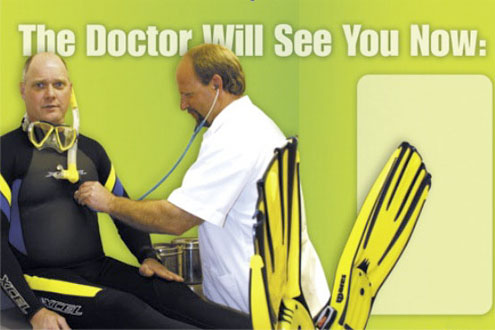Diving Medical

While we all like to enjoy ourselves underwater there are risks involved, especially for those with some medical conditions. The Australian Standards organisation, various state and federal regulators, together with the diving industry and representatives of recreational divers, have combined to put in place requirements and medical standards for SCUBA diving in Australia.
Because of the strict requirements of these standards, and the consequences of not adhering to them, prior to diving or training with them, most dive centres and operators will require you to fill in a comprehensive medical statement.
If you answer YES to any question you will be referred to a qualified physician for a Dive Medical assessment that conforms to Australian Standard AS4005-1. Overseas dive medicals are generally not accepted unless they are equal or better than the AS4005.1 standard.
At The Scuba Doctor if you are under 16 years old, or are aged 45 or more, we will also require that you undertake a full Dive Medical assessment, unless you can show us you've had one in the last five years.
This strict adherence to dive safety standards, including the Dive Medical, by all diving instructors recommended by The Scuba Doctor, shows the safety benefit of this approach to personal safety and risk management.
The requirement for a Dive Medical is ultimately for your own safety.
Where To Get A Dive Medical
Some of the diving doctors we know and recommend locally on the Mornington Peninsula and around Melbourne are:
| Dive Medical Doctors | |
|---|---|
| Doctor | Telephone |
| Dr Guy Williams Rosebud Medical Clinic 1239-1241 Pt Nepean Road, Rosebud VIC 3939 Melway: 170 C1 | Get directions | 03 5981 1555 |
| Dr Adrian Murrie Sorrento Medical Centre 166 Ocean Beach Road, Sorrento VIC 3943 Melway: 157 A8 | Get directions | 03 5984 4322 |
| Dr John Roth Mornington Medical Group 258 Main Street, Mornington VIC 3931 Melway: 104 E12 | Get directions | 03 5975 2633 |
| Dr Vanessa Haller Carrum Downs Medical Centre 113a Hall Road, Carrum Downs VIC 3201 Melway: 100 H2 | Get directions | 03 9782 6666 |
The South Pacific Underwater Medical Society (SPUMS) has a full list of AS4005.1 certified physicians.
Cancelling The Right To Dive Anyway
Regardless of whether you have a current Dive Medical Certificate, a dive operator has the power to exclude you from participating in diving activities. The instructors recommended by The Scuba Doctor all reserve the right to also do this.
More Information
For more information about Australian dive medicals and dive medical requirements, please visit the informative web site Dive Medicals Online.
Regular Dive Medicals
If you are a diver who answers YES to any question in the Medical Questionnaire, then we'd suggest you consider getting a regular dive medical. Maybe do it every year, every two years, or as your dive doctor recommends. If you're an active diver then the more thorough dive medical is a worthwhile thing to do.

